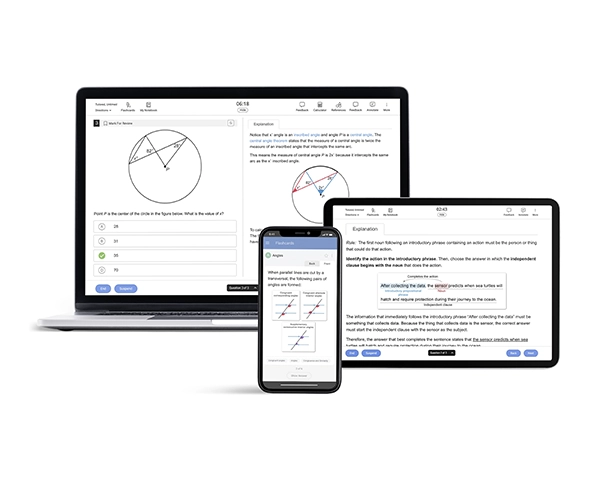Not all calculators are created equal, especially when it comes to the SAT®. While not every section requires one, using the best SAT calculator can save time, reduce mistakes, and help you stay focused during the Math section. But with so many models out there (some banned!), how do you choose the right one? This article breaks it down.
What Types of Calculators Are Used for the SAT?
Understanding the basic types of calculators helps you quickly rule out what's allowed — and what's not.
| Type of Calculators | Details |
|---|---|
| Graphing | Advanced models with graphing functions and memory storage. Many are allowed, but not all. |
| Scientific | Great for complex math functions like logarithms and exponents. Most are SAT-approved. |
| Four-function | Basic models with addition, subtraction, multiplication, and division. Allowed but not recommended due to limited features. |
Why Choosing the Best SAT Calculator Matters
The calculator you bring can affect more than just a few tricky questions. A reliable, SAT-approved calculator boosts your speed, accuracy, and confidence. It helps manage time effectively, especially on grid-in questions or problems involving data analysis. The best calculator for the SAT test isn't necessarily the fanciest, it's the one that works fast and follows College Board® rules.
Features to Look for in the Best SAT Calculator
To make your test day smoother, prioritize these features when selecting a calculator:
- Ease of use – Avoid complex interfaces that slow you down.
- Long battery life – Make sure it won't power off mid-test.
- SAT-approved functions – Stay within the rules (no CAS or wireless features).
- Quick-access keys – For functions like square roots, exponents, or memory recall.
- Readable screen – Especially for graphing models.
Top Recommendations: Best Calculator for SAT
Here are some of the best SAT calculator options trusted by test-takers and approved by the College Board:
| Model | Type | Pros | Cons |
|---|---|---|---|
| TI-84 Plus CE | Graphing | Large display, fast processing, SAT-approved | Slight learning curve |
| Casio fx-9750GII | Graphing | Budget-friendly, intuitive UI | No color screen |
| TI-83 Plus | Graphing | Reliable, widely used, fast function keys | Dated design |
| Casio fx-115ES PLUS | Scientific | Lightweight, non-graphing, affordable | No graphing |
| Sharp EL-W516XBSL | Scientific | Great memory recall, multi-line display | Slightly bulky |
| TI-30XS Multiview | Scientific | Simple and student-friendly | Not for graph-heavy questions |
SAT Calculator Policy (with May 2025 Update)
According to the College Board's updated SAT calculator policy, you're allowed to use approved calculators only during the Math section that permits them. Key points include:
- Most graphing and scientific calculators are allowed.
- Calculators with CAS (Computer Algebra System) capabilities are not allowed.
- Smart devices, wireless, and QWERTY-keyboard calculators are prohibited.
- The Desmos on-screen calculator is built into the Digital SAT and available for the entire Math section.
For a complete breakdown of the rules and updated list of SAT approved calculators, read our SAT calculator policy.
Which SAT Sections Allow Calculator Use?
The Math section is divided into two parts:
- Calculator section: You can bring/use your own SAT-approved calculator.
- Non-calculator section: No calculator allowed — even if permitted by model.
UWorld's full-length SAT practice simulates both sections with or without calculators to help you prep smarter.
Acceptable/Approved SAT Calculators
The College Board provides a list of SAT test approved calculators, including many from the TI, Casio, and Sharp series. Some of the most reliable models include:
| Casio | Hewlett-Packard | Texas Instruments | Sharp | Others |
|---|---|---|---|---|
| FX-9750GII | HP-9G | TI-73 | EL-5200 | NumWorks |
| FX-9860GII | HP-38G | TI-80 to TI-86 | EL-9200 series | Desmos (built-in) |
| FX-CG10 | HP-39G series (excluding CAS models) | TI-83/84/Plus/CE models (except CAS) | EL-9300 series | Datexx DS-883 |
| FX-CG20 | TI-Nspire (non-CAS only) | EL-9900 | Micronta | |
| FX-CG50 | ||||
| FX-7400GII | ||||
| FX-7700 series |
Prohibited Calculators on the SAT
Some calculators are disallowed on the SAT due to advanced features like internet access, programming functions, or symbolic algebra systems (CAS). These tools can give an unfair advantage and violate the College Board's calculator policy.
Commonly prohibited models include:
- TI-Nspire CX CAS – Features CAS, which can solve algebraic expressions symbolically. Only the non-CAS version is permitted.
- TI-89 series – Includes advanced functions and CAS; not allowed.
- Casio ClassPad – Offers touchscreen and symbolic algebra tools; disallowed.
- HP Prime Graphing Calculator – Contains CAS and wireless capabilities; not SAT-approved.
For a safe experience on test day, double-check your calculator model against the official list of SAT-approved devices.
UPDATE: The CAS Calculator Ban (Effective May 2025!)
The updated SAT calculator policy, effective May 2025, reaffirms that CAS calculators are not permitted on the exam. CAS stands for Computer Algebra System, a feature found in some advanced calculators that can perform symbolic algebra such as factoring, expanding, and solving equations in exact form rather than numerical approximations.
While powerful, CAS capabilities provide an unfair advantage by doing too much of the thinking for you. As a result, calculators with CAS — like the TI-Nspire CX CAS, TI-89 series, or Casio ClassPad — are strictly prohibited.
If you're unsure whether your calculator includes CAS, consult the user manual or check the model specifications on the manufacturer's website before test day.
How Can You Check If Your Calculator Is Non-CAS?
To avoid test day issues, it's important to make sure your calculator does not include CAS (Computer Algebra System) functionality. Here's how you can check:
- Look for trusted non-CAS models like the TI-84 Plus CE or Casio fx-9750GII — these are fully SAT-approved.
- Avoid calculators with “CAS” in the name (e.g., TI-Nspire CX CAS), as they're automatically disqualified.
- Review your calculator's manual or product specs on the manufacturer's website.
- Cross-reference it with the official SAT calculator policy.
Why it matters:
Bringing a banned calculator could result in being dismissed from the testing room or having your scores canceled. Confirming your calculator is non-CAS and approved ensures a stress-free testing experience.
Key Takeaways
When preparing for the SAT, it's essential to use a SAT test approved calculator listed by the College Board. These models are vetted for fairness and functionality during the Math section. Be sure to avoid any calculator that includes CAS capabilities, wireless communication, or QWERTY-style keyboards, as these are strictly prohibited.
If you're searching for the best calculator for SAT test success, look beyond basic eligibility. Consider factors like ease of use, screen clarity, and battery life — these features can significantly enhance your speed and confidence during the exam. It's also smart to practice with the same calculator you'll use on test day, so you're completely comfortable with its functions and layout.
To simulate the real testing experience, UWorld's built-in SAT calculator mirrors the one provided on the Digital SAT. It's a practical way to build confidence while mastering test-style questions in a digital format.
Frequently Asked Questions (FAQs)
Visit the College Board’s calculator policy page or check the model against their downloadable list. Avoid any device that connects to the internet or includes CAS features.
Yes! The Desmos on-screen calculator is built into the Digital SAT and is allowed for the entire Math section. It’s user-friendly, graph-enabled, and approved by the College Board.










